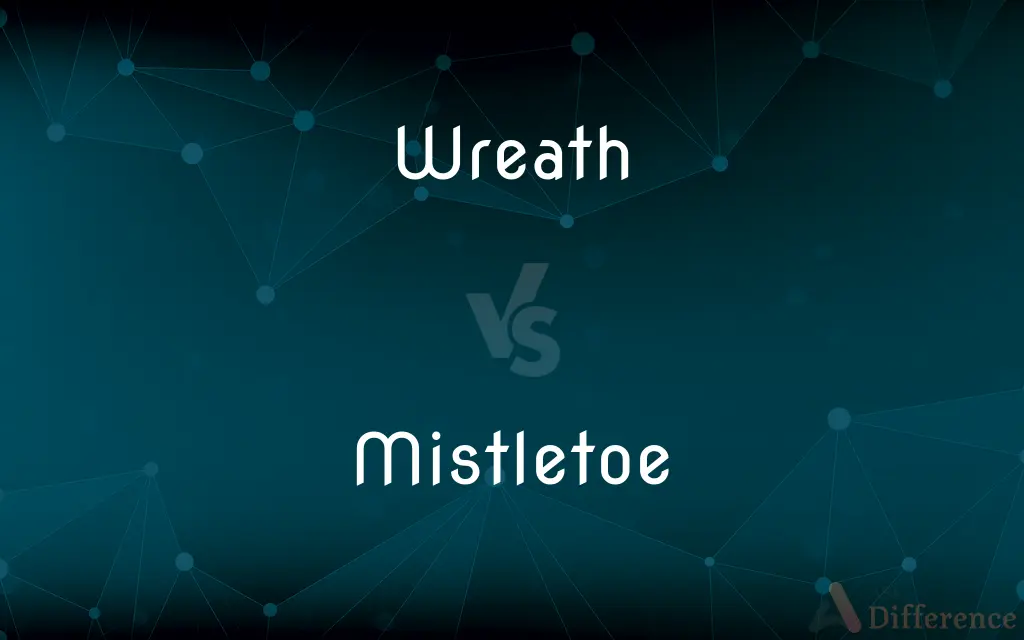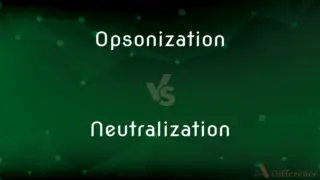Wreath vs. Mistletoe — What's the Difference?
By Tayyaba Rehman — Updated on December 17, 2023
Wreath is a circular arrangement of flowers, leaves, or stems. Mistletoe is a parasitic plant with white berries, traditionally used for holiday decorations.

Difference Between Wreath and Mistletoe
Table of Contents
ADVERTISEMENT
Key Differences
Wreaths and Mistletoe are both associated with holiday traditions but differ significantly in form and symbolism. A wreath is a circular arrangement of foliage, flowers, or various materials, often used as a decorative piece for doors or walls. It symbolizes eternal life and growth due to its circular shape. In contrast, Mistletoe is a plant known for its green leaves and white berries. It is typically hung in doorways during the Christmas season and is associated with the custom of kissing underneath it.
The origins and cultural significance of wreaths and mistletoe vary. Wreaths have historical significance in various cultures, including the ancient Greeks and Romans, and are used year-round for different occasions. They are not exclusively tied to Christmas and can represent various themes depending on their composition. Mistletoe, on the other hand, has specific ties to Christmas and winter celebrations and is steeped in folklore, particularly in European traditions, symbolizing peace and love.
The use of wreaths and mistletoe in holiday decor differs. Wreaths are versatile and can be made from various materials, including evergreen branches, flowers, and ribbons, making them suitable for various occasions and seasons. They are often seen as welcoming symbols when placed on doors. Mistletoe, with its distinctive appearance, is mainly used during Christmas, with the custom of kissing under mistletoe adding a romantic element to its usage.
The making and displaying of wreaths can be a creative and diverse activity, allowing for a wide range of styles, sizes, and materials. They can be elaborate or simple, tailored to specific themes or seasonal elements. Mistletoe is usually displayed in its natural form, often tied with a ribbon and hung from ceilings or door frames. Its display is more uniform and tied closely to its traditional Christmas association.
In terms of symbolism, wreaths offer broader interpretive possibilities. They can represent victory, honor, or seasonal changes. In contrast, mistletoe has a more focused symbolic meaning, predominantly associated with love, fertility, and the custom of kissing under it during Christmas celebrations, making it a unique and specific element of holiday traditions.
ADVERTISEMENT
Comparison Chart
Form
Circular arrangement of foliage/materials
Parasitic plant with green leaves and white berries
Symbolism
Eternal life, growth, victory, honor
Love, fertility, Christmas tradition
Usage
Decorative piece for various occasions
Hung in doorways during Christmas
Variability
Diverse materials and styles
Typically natural form, less variability
Cultural Significance
Broad in various cultures and occasions
Specifically tied to Christmas and folklore
Compare with Definitions
Wreath
A circular arrangement of flowers and foliage.
The holiday wreath on the door was adorned with red berries and pine cones.
Mistletoe
A plant used for holiday decorations.
They hung mistletoe above the doorway for the Christmas party.
Wreath
A decorative piece for various occasions.
They hung a fragrant eucalyptus wreath in the living room.
Mistletoe
A symbol of love and fertility.
The mistletoe in the foyer reminded them of ancient traditions.
Wreath
A symbol of victory or honor.
The athlete was awarded a laurel wreath for his triumph.
Mistletoe
A traditional Christmas ornament.
She added a sprig of mistletoe to the holiday centerpiece.
Wreath
An arrangement symbolizing eternal life.
The evergreen wreath represented the cycle of seasons.
Mistletoe
Associated with the custom of kissing.
Standing under the mistletoe, they shared a romantic kiss.
Wreath
A festive door decoration.
Their Christmas wreath was beautifully lit with twinkling lights.
Mistletoe
A parasitic plant with white berries.
The mistletoe thrived high in the oak tree's branches.
Wreath
A wreath () is an assortment of flowers, leaves, fruits, twigs, or various materials that is constructed to form a ring.In English-speaking countries, wreaths are used typically as household ornaments, most commonly as an Advent and Christmas decoration. They are also used in ceremonial events in many cultures around the globe.
Mistletoe
Mistletoe is the common name for obligate hemiparasitic plants in the order Santalales. They are attached to their host tree or shrub by a structure called the haustorium, through which they extract water and nutrients from the host plant.
Wreath
An arrangement of flowers, leaves, or stems fastened in a ring and used for decoration or for laying on a grave
The Queen laid a wreath at the Cenotaph
A laurel wreath
Mistletoe
Any of various hemiparasitic plants of the order Santalales that grow on the branches of other plants, especially Viscum album of Eurasia and Phoradendron leucarpum of North America, both of which have leathery evergreen leaves and waxy white berries. Extracts of the Eurasian species are sometimes used for medicinal purposes.
Wreath
A curl or ring of smoke or cloud
Wreaths of mist swirled up into the cold air
Mistletoe
A sprig of mistletoe, often used as a Christmas decoration.
Wreath
A snowdrift.
Mistletoe
Any of numerous hemiparasitic evergreen plants of the order Santalales with white berries that grow in the crowns of apple trees, oaks, and other trees, such as the European mistletoe (Viscum album) and American mistletoe or eastern mistletoe (Phoradendron leucarpum).
Wreath
A ring or circlet of freshly cut or dried flowers, boughs, or leaves worn on the head, placed on a memorial, or hung as a decoration.
Mistletoe
(uncountable) A sprig of one such plant used as a Christmas decoration, associated with the custom that a man may kiss any woman standing beneath it.
Wreath
A similar ornamental ring made of wood, plastic, or other materials.
Mistletoe
A parasitic evergreen plant of Europe (Viscum album), bearing a glutinous fruit. When found upon the oak, where it is rare, it was an object of superstitious regard among the Druids. A bird lime is prepared from its fruit.
Wreath
A curling or circular form
A wreath of smoke.
Mistletoe
American plants closely resembling Old World mistletoe
Wreath
Something twisted, intertwined, or curled.
A wreath of smoke;
A wreath of clouds
Mistletoe
Old World parasitic shrub having branching greenish stems with leathery leaves and waxy white glutinous berries; the traditional mistletoe of Christmas
Wreath
An ornamental circular band made, for example, of plaited flowers and leaves, and used as decoration; a garland or chaplet, especially one given to a victor.
Mistletoe
Shrub of central and southeastern Europe; partially parasitic on beeches, chestnuts and oaks
Wreath
(heraldry) An appendage to the shield, placed above it, and supporting the crest; an orle, a torse. It generally represents a twist of two cords of silk, one tinctured like the principal metal, the other like the principal color in the coat of arms.
Wreath
A defect in glass.
Wreath
(transitive) To place an entwined circle of flowers upon or around something.
Wreath
(transitive) To wrap around something in a circle.
At the funeral, a circle of comrades wreathed the grave of the honored deceased.
Wreath
(intransitive) To curl, writhe or spiral in the form of a wreath.
Wreath
Something twisted, intertwined, or curled; as, a wreath of smoke; a wreath of flowers.
[He] of his tortuous trainCurled many a wanton wreath.
Wreath
A garland; a chaplet, esp. one given to a victor.
Conquest doth grantHe dear wreath to the Grecian combatant.
Far back in the ages,The plow with wreaths was crowned.
Wreath
An appendage to the shield, placed above it, and supporting the crest (see Illust. of Crest). It generally represents a twist of two cords of silk, one tinctured like the principal metal, the other like the principal color in the arms.
Wreath
Flower arrangement consisting of a circular band of foliage or flowers for ornamental purposes
Wreath
Encircle with or as if with a wreath;
Her face was wreathed with blossoms
Common Curiosities
Is mistletoe only used during Christmas?
Mistletoe is primarily associated with and used during the Christmas season.
Can wreaths be used year-round?
Yes, wreaths can be designed for various seasons and occasions.
What materials are used to make wreaths?
Wreaths can be made from evergreens, flowers, ribbons, and various decorative materials.
Can wreaths have different meanings?
Yes, wreaths can symbolize victory, honor, mourning, or seasonal changes.
What is a wreath?
A wreath is a circular arrangement of materials like flowers or foliage.
What does mistletoe represent?
Mistletoe symbolizes love, fertility, and the tradition of kissing under it during Christmas.
Are wreaths always circular?
Traditionally, wreaths are circular, symbolizing eternal life and continuity.
Where is mistletoe commonly found?
Mistletoe is commonly found growing on trees like oak and apple.
Why do people kiss under mistletoe?
Kissing under mistletoe is a Christmas tradition stemming from ancient folklore.
Are wreaths only for Christmas?
No, wreaths can be used for various holidays and occasions.
Is mistletoe a plant or a decoration?
Mistletoe is a parasitic plant that is also used as a holiday decoration.
Do wreaths have religious significance?
Wreaths can have religious significance, especially in Christian traditions.
How is mistletoe used in holiday decor?
Mistletoe is typically hung in doorways or ceilings as a part of Christmas decoration.
What is the history behind wreaths?
Wreaths have a rich history, with origins in ancient Greece and Rome for various purposes.
Can mistletoe be artificial?
Yes, artificial mistletoe is available for decoration purposes.
Share Your Discovery

Previous Comparison
Opsonization vs. Neutralization
Next Comparison
Stator vs. AlternatorAuthor Spotlight
Written by
Tayyaba RehmanTayyaba Rehman is a distinguished writer, currently serving as a primary contributor to askdifference.com. As a researcher in semantics and etymology, Tayyaba's passion for the complexity of languages and their distinctions has found a perfect home on the platform. Tayyaba delves into the intricacies of language, distinguishing between commonly confused words and phrases, thereby providing clarity for readers worldwide.















































